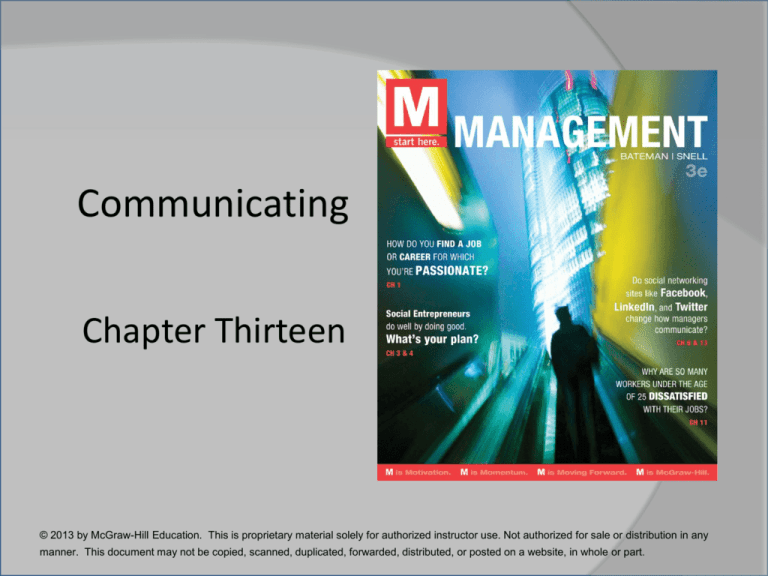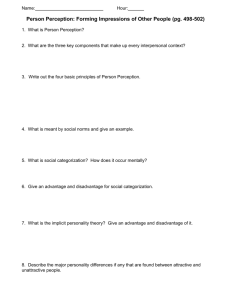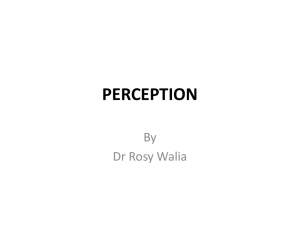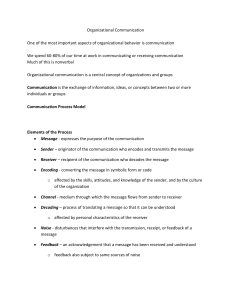
Communicating
Chapter Thirteen
© 2013 by McGraw-Hill Education. This is proprietary material solely for authorized instructor use. Not authorized for sale or distribution in any
manner. This document may not be copied, scanned, duplicated, forwarded, distributed, or posted on a website, in whole or part.
Interpersonal Communication
Communication
The transmission of information and meaning
from one party to another through the use of
shared symbols
13-4
Perception and
Communication Problems
Basic Perception
Process
Perception
Problems
Perceptions
of Others
Self-Perception
5
13-5
Basic Perception Process
Perception
The process by which individuals attend
to, organize, interpret, and retain
information from their environments.
Perception Filters
The personality-, psychology-, or
experienced-based differences that
influence people to ignore or pay attention
to particular stimuli. People exposed to
the same information will often disagree
about what they saw or heard.
6
13-6
Basic Perception Process
Stimulus
Stimulus
Stimulus
Perceptual
Attention
Filter
Perceptual
Organization
Filter
Perceptual
Interpretation
Filter
Perceptual
Retention
Filter
7
13-7
Basic Perception Process
Attention-the process of noticing
particular stimuli.
Organization-the process of incorporating
new information into your existing
knowledge.
Interpretation-the process of attaching
meaning to new knowledge.
Retention-the process of remembering
interpreted information.
13-8
Perceptual Challenges:
What Do You See?
Copyright © 2005 Prentice
Hall, Inc. All rights reserved.
Exhibit 8.5
8–9
13-9
Influences on Perception
Personal
Target characteristics
Characteristics of the
target and its relationship
to its background.
Contextual elements, such
as time, location, light, or
heat.
characteristics
Attitudes
Personality
Motives
Interests
Past experiences
Expectations
Copyright © 2005 Prentice
Hall, Inc. All rights reserved.
8–10
13-10
Perception Problems
At work, we are constantly bombarded with sensory
stimuli—the phone ringing, people talking in the
background, the sounds of our computers dinging as
new e-mail arrives, people calling our names, etc.
We cannot possibly notice, receive, and interpret all
of this information.
As a result, we attend to and accept some stimuli but
screen out and reject others.
Selective perception
• notice and accept stimuli which are consistent with our values
and beliefs
• ignore inconsistent stimuli
Closure
• tendency to fill in the gaps when information is missing
• we assume that what we don’t know is consistent with what we
11
do know
13-11
Perception of Others
Attribution Theory
we have a need to understand and explain
the causes of other people’s behavior; we
need to know why people do what they do).
General reasons to explain behavior
Internal attribution
• the behavior was voluntary or under their control
External attribution
• the behavior was involuntary and beyond their control
12
13-12
Attribution Bias and Error
Defensive
Bias
The tendency for people to
perceive themselves as personally and
situationally similar to someone who is
having difficulty. We tend to use external
attributions to explain behavior.
Fundamental
Attribution
Error
The tendency to ignore external causes
of behavior and to attribute other
people’s actions to internal causes.
Which attribution, the defensive bias or the fundamental attribution
error, are workers likely to make when something goes wrong?
13
13-13
Attribution Bias and Error
14
13-14
Self-Perception
Self-Serving Bias
The tendency to overestimate our value by
attributing successes to ourselves
(internal causes) and attributing failures to
others or the environment (external
causes).
The self-serving bias can make it especially difficult
for managers to talk to employees about
performance problems.
15
13-15
The Interpersonal Communication Process
Sender
Message
to be
Conveyed
Encode
Message
2.1
Transmit
Message
Receiver
Feedback to Sender
N
o
i
s
e
N
o
i
s
e
N
o
i
s
e
N
o
i
s
e
Communication Channel
Message
that was
Understood
Decode
Message
Receive
Message
16
Interpersonal Communication
The sender initiates the process by conveying
information to the receiver —the person for whom
the message is intended.
The sender has a meaning he or she wishes to
communicate and encodes the meaning into
symbols (the words chosen for the message).
Then the sender transmits, or sends, the message
through some channel, such as a verbal or written
medium.
13-17
Interpersonal Communication
The receiver decodes the message (e.g.,
reads it) and attempts to interpret the
sender’s meaning.
The receiver may provide feedback to the
sender by encoding a message in response to
the sender’s message.
13-18
Interpersonal Communication
Noise
interference in the
system
blocks perfect
understanding
Examples of Noise
ringing telephones
thoughts about other
things
simple fatigue or
stress
13-19
A General Model of
Communication
Exhibit 13.1
13-20
One-Way Communication
is Common
One-way communication
A process in which information flows in only one
direction—from the sender to the receiver, with
no feedback loop.
13-21
Communication Should Flow
in Two Directions
Two-way communication
A process in which information flows in two
directions—the receiver provides feedback, and
the sender is receptive to the feedback.
13-22
A Model of Two-way
Communication
Exhibit 13.2
13-23
Avoiding Communication Problems
Ensure that the receivers attend to the message
they are sending.
Consider the other party’s frame of reference
and attempt to convey the message with that
viewpoint in mind.
Take concrete steps to minimize perceptual
errors and improper signals in sending and
receiving.
Send consistent messages
13-25
Oral and Written Channels
Oral communication
includes face-to-face
discussion, telephone
conversations, and
formal presentations
and speeches
Written
communication
includes e-mail,
memos, letters,
reports, computer
files, and other
written documents
13-26
Advantages and Disadvantages of Oral
and Written Communication
Exhibit 13.3
13-27
Electronic Media Offer Flexible,
Efficient Channels
Web 2.0
A set of Internet-based applications that
encourage user-provided content and
collaboration
social networking, podcasts, RSS, and wikis
13-28
Advantages and Disadvantages of
Using Electronic Media at Work
Exhibit 13.4
13-29
The Virtual Office
Virtual office
A mobile office in which people can work anywhere,
as long as they have the tools to communicate with
customers and colleagues.
• Positives
– Able to close branch offices
– Salespeople can spend more time with customers
– Most people like the flexibility
• Negatives
–
–
–
–
Loss of “human moments”
Some people hate being forced to work at home
Long hours can cause burnout
Direct supervision may be necessary to maintain quality of work.
13-30
Use “Richer” Media for
Complex or Critical Messages
Media richness
The degree to which a
communication
channel conveys
information.
Send difficult and
unusual messages
through rich media,
more routine
messages through
poorer media.
13-31
The Information Richness of Communication
Media
13-32
What Communication
Channel Would You Use?
13-33
Suggested Media Choices for
Sample Situations
Exhibit 13.5
13-34
Nonverbal Skills
Nonverbal signals convey meaning, too
Use time appropriately
Make your office arrangement conducive to open
communication
Remember your body language
13-37
Listening
Reflection
Process by which a
person states what he
or she believes the
other person is saying
13-38
Listening
• Most people are terrible listeners, retaining
only about 25% of what they hear.
• About 45% of total communication time is
spent listening.
© 2012 Cengage Learning
Active Listening
Assuming half the responsibility for successful
communication by actively giving the speaker
nonjudgmental feedback that shows you’ve
accurately heard what he or she said.
•Clarify responses
•Paraphrase
•Summarize
© 2012 Cengage Learning
Clarifying, Paraphrasing,
and Summarizing Responses
for Active Listeners
© 2012 Cengage Learning
Ten Keys to Effective Listening
Find an area of
interest
Judge content, not
delivery
Hold your fire
Listen for ideas
Be flexible
Resist distraction
Exercise your mind.
Keep your mind open
Capitalize on thought
speed
Work at listening
13-42
Observing
A vital source of useful observations comes
from personally visiting people, plants, and
other locations to get a firsthand view
You must accurately interpret what you
observe
Commonly know as MBWA
13-43
Formal Communication
Channel
The system of official channels that carry
organizationally approved messages and
information.
Downward
communication
Upward
communication
© 2012 Cengage Learning
Horizontal
communication
Downward Communication Directs,
Motivates, Coaches, and Informs
Downward communication
Information that flows from higher to lower
levels in the organization’s hierarchy
The flow of information affects how well people
perform.
Communication that provides relevant
information helps create employee identification
with the company, supportive attitudes, and
decisions consistent with the organization’s
objectives.
13-45
Coaching
Coaching
Dialogue with a goal of helping another be more
effective and achieve his or her full potential on
the job.
Use as a sounding board, helping you think
through the potential impact of your ideas,
generate new options, and learn from
experience.
13-46
Open-Book Management
Open-book management
Practice of sharing with employees at all levels of
the organization vital information previously
meant for management’s eyes only
Steps toward open-book management
• Provide the information
• Teach basic finance and the basics of the business
• Empower people to make decisions based on what they
know
• Make sure everyone shares directly in the company’s
success (and risks)such as through stock ownership and
bonuses
13-47
Upward Communication
is Invaluable to Management
Upward
communication
Information that flows
from lower to higher
levels in the
organization’s hierarchy.
Managing upward
communication.
• Managers should facilitate
upward communication.
• Managers should motivate
people to provide valid
information
13-48
Horizontal Communication
Fosters Collaboration
Horizontal communication
Information shared among people on the same
hierarchical level
allows units to share information, coordinate
work, and solve mutual problems
helps resolve conflicts
provides social and emotional support to people.
13-49
Common Problems with Downward,
Upward, and Horizontal Communication
© 2012 Cengage Learning
Information Loss in
Downward Communication
Exhibit 13.6
13-51
Four Modes of Work
13-52
The Grapevine
“The grapevine motto: Good
information passes among
people fairly rapidly—bad
information, even faster!”
Grapevine
An unofficial channel of
communication that is
neither authorized nor
supported
by the organization.
Copyright © 2005 Prentice
Hall, Inc. All rights reserved.
12–54
13-54
The Grapevine
Exhibit 12.2
Copyright © 2005 Prentice
Hall, Inc. All rights reserved.
12–55
13-55
Informal Communication
Channels
Gossip
Chain
Cluster
Chain
“Highly-connected” worker shares
information with coworkers
Numerous people tell a friend.
56
Informal Communication
Grapevine
provides people with information
helps them solve problems
teaches them how to do their work successfully
13-57
Managing Organizational
Grapevines
• Don’t withhold information from it
• Don’t punish those who use it
• Embrace the grapevine and keep
employees informed
• Use it as a source of information
2.3
58
Managing Rumors
If a manager hears a story that could get out of
hand, he should talk to the key people involved
to get the facts and their perspectives
Dispel uncertainties by providing facts; and
establish open communications and trust over
time.
A manager should neutralize rumors once they
have started
13-59
Boundaryless Organizations
Boundaryless organization
organization in which there are no barriers to
information flow
implies information available as needed moving
quickly and easily enough so that the
organization functions far better as a whole than
as separate parts.
13-60
http://bevideos.mhhe.com/business/video_li
brary/0077424611/swf/Clip_14.html
13-61
13-61
Video: In Good Company
Describe how Gore encourages horizontal
communication.
How well does Gore practice open-book
management?
13-62









